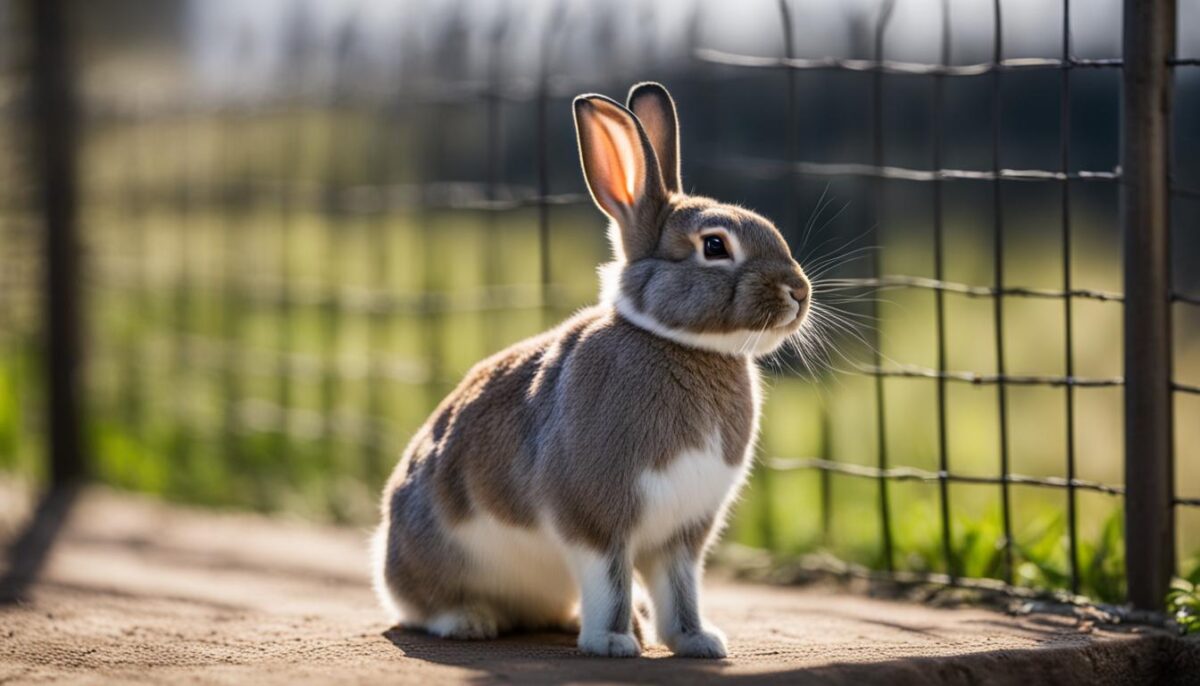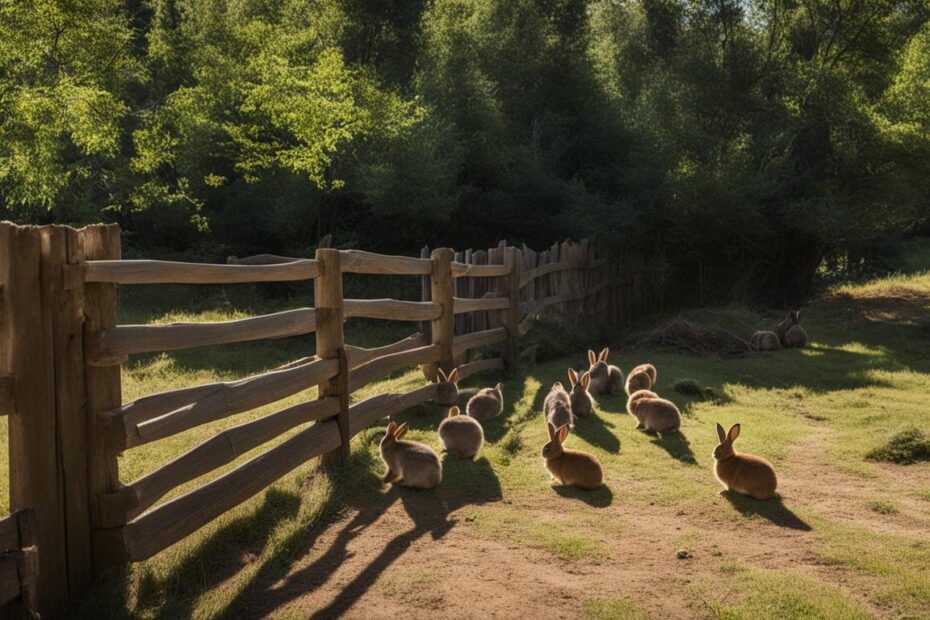Are you curious about whether rabbits have the ability to climb fences? In this article, we will explore fascinating details about rabbit behavior and their climbing abilities. Whether you are considering rabbit fencing or simply want to understand more about these adorable creatures, this article will provide you with valuable insights.
Did you know that rabbits have incredibly keen hearing? They can detect sounds up to 2 miles away and can even rotate their ears to pinpoint the direction of the noise! Additionally, rabbits have a unique way of regulating their body temperature through their ears, which is quite fascinating.
Contrary to popular belief, wild rabbits do not primarily rely on carrots as a food source. Instead, they prefer low-lying plants, grass, berries, and tree bark. If you have a pet rabbit, it’s important to provide them with a healthy diet of leafy greens rather than relying solely on carrots.
Have you ever witnessed a rabbit perform a joyful behavior called a “binky?” This delightful display involves leaping in the air, twisting their bodies, and kicking their feet to signal happiness and excitement. It’s a joyful sight to behold!
- Rabbits have keen hearing and can detect sounds up to 2 miles away.
- Wild rabbits prefer low-lying plants, grass, berries, and tree bark as their primary food sources.
- Leafy greens are a healthier option for pet rabbits compared to a diet solely based on carrots.
- Rabbits exhibit a joyful behavior called a “binky,” where they leap in the air to show happiness and excitement.
Why Rabbits Are Not Known for Climbing
Rabbits are fascinating creatures with unique behaviors and adaptations that help them survive in their natural habitats. While they are agile and quick on their feet, rabbits are not known for their climbing abilities. This is due to several factors related to their behavior and habitat.
As prey animals, rabbits have evolved to rely on their speed and agility to escape from predators. Their bodies are not adapted for climbing, and they lack the necessary features such as retractable claws or prehensile tails that would enable them to ascend vertical surfaces. Instead, rabbits have powerful hind legs that are designed for sprinting and quick movements, allowing them to swiftly navigate their surroundings.
Rabbits prefer open fields and burrows as their natural habitats, where they can utilize their speed and agility to escape from potential threats. Their behavior and habitat reflect their ground-dwelling nature, as they rely on their ability to sprint and quickly change direction to evade predators. Climbing trees or fences is not a common behavior for rabbits and is not an essential part of their survival strategy.
| Rabbit Climbing Ability | Rabbit Habitat | Predator Protection |
|---|---|---|
| Not specialized climbers | Open fields and burrows | Reliance on speed and agility |
| Lack of climbing adaptations | Ground-dwelling nature | Swift evasion of predators |
| Powerful hind legs for sprinting | Preference for low-lying habitats | Escape from potential threats |
In conclusion, while rabbits are incredible animals with their unique locomotion and behaviors, climbing is not one of their specialties. Their bodies are not designed for climbing, and their natural habitats and predator evasion strategies do not require them to possess climbing abilities. Instead, rabbits rely on their speed, agility, and quick movements to navigate their surroundings and stay safe in their environments.
The Unique Locomotion of Rabbits
Rabbits have a distinct form of locomotion, primarily characterized by hopping. This mode of movement is propelled by their strong hind legs, which provide powerful bursts of speed. While hopping, the front legs assist with balance and guidance, allowing rabbits to navigate their surroundings quickly and efficiently. This unique form of locomotion showcases their agility and dexterity.
Rabbits utilize their hopping ability to explore their environment and evade potential threats. Their bodies are not designed for climbing, as they lack the adaptations needed for gripping or ascending vertical surfaces. Instead, their muscular hind legs enable impressive leaps, which can reach heights of up to 3 feet. It’s important to note that while rabbits can exhibit vertical movements, true climbing behaviors are not natural or common for them.
With their ability to hop, rabbits are able to cover ground rapidly and easily maneuver through various terrains. This mode of movement also allows them to escape predators quickly, utilizing their agility to evade capture. It’s fascinating to observe their graceful hops and their swift response to stimuli in their environment.
The Physical Adaptations for Hopping
Rabbits’ unique locomotion is facilitated by several physical adaptations. Their hind legs are longer and more muscular than their front legs, providing the necessary power for hopping. These powerful hind legs generate forceful propulsion, while their lightweight bodies and long, flexible spine aid in maintaining balance and stability during rapid movements.
Furthermore, their back legs feature a unique joint structure known as a “double-jointed” hock, which allows for efficient extension and flexion of the legs during each hop. This specialized joint mechanism helps maximize the energy transfer and contributes to the swift and agile nature of a rabbit’s locomotion.
| Key Adaptations for Hopping | Description |
|---|---|
| Strong Hind Legs | Provide powerful bursts of speed and forceful propulsion |
| Long, Flexible Spine | Aids in maintaining balance and stability during rapid movements |
| “Double-Jointed” Hock | Allows efficient extension and flexion of the legs during each hop |
Rabbit Body Language and Behavior
Understanding rabbit body language is essential for rabbit owners to gauge their pet’s emotions and needs. Rabbits communicate through a variety of behaviors and postures, providing valuable insights into their well-being and level of comfort. By observing their body language, owners can better understand their rabbit’s mood and respond accordingly.
Rabbits are naturally curious animals and enjoy exploring their surroundings. They may exhibit behaviors such as rearing up on their hind legs or jumping onto small platforms to get a better view. These actions are not true climbing but rather ways for rabbits to satisfy their curiosity and engage with their environment. By offering safe exploration opportunities, such as tunnels and hiding spots, owners can encourage their rabbits’ natural instincts and provide mental stimulation.
Rabbit body language also includes a variety of gestures and postures. Thumping is a common behavior that rabbits display when they perceive danger. By forcefully hitting their hind legs on the ground, rabbits create a loud noise to alert others and communicate potential threats. Another notable behavior is lying on their side, which indicates contentment and relaxation. It’s important for owners to be familiar with these body language cues to ensure the well-being of their rabbits.
Rabbit Body Language Signals
To assist owners in understanding rabbit body language, here are some key signals to look out for:
- Thumping: Indicates perceived danger or alarm.
- Lying on the side: Reflects contentment and relaxation.
- Exploration behavior: Rearing up on hind legs or jumping onto platforms to explore their environment.
By paying attention to these signals, owners can create a stronger bond with their rabbits and ensure their well-being.

| Behavior | Meaning |
|---|---|
| Thumping | Perceived danger or alarm |
| Lying on the side | Contentment and relaxation |
| Exploration behavior | Rearing up on hind legs or jumping onto platforms to explore their environment |
Debunking the Myths of Rabbits Climbing
There are numerous myths surrounding rabbits and their climbing abilities. Many people believe that rabbits can climb trees or scale walls, but these misconceptions are often based on misunderstood behaviors or anecdotal evidence. In reality, rabbits are not natural climbers and lack the necessary adaptations for climbing.
When rabbits jump onto platforms or higher objects, it is not climbing but rather a display of their agility. Rabbits have powerful hind legs that allow them to make impressive leaps, but their bodies are not designed for gripping or ascending vertical surfaces. Unlike animals such as cats or squirrels, rabbits lack retractable claws and a prehensile tail, which are essential for climbing.
“While rabbits can exhibit vertical movements, true climbing behaviors are not natural or common for them.”
Rabbits prefer to stay close to the ground and rely on their speed and agility to escape predators. Their behavior and habitat reflect their preference for open fields and burrows rather than climbing trees or other elevated structures. So the next time someone tells you that rabbits can climb, you can confidently debunk that myth and explain the true nature of rabbits’ abilities.
| Myth | Fact |
|---|---|
| Rabbits can climb trees. | Rabbits are not natural climbers and lack the necessary adaptations for climbing. |
| Rabbits can scale walls. | Rabbits rely on their speed and agility, not climbing, to escape predators. |
| Rabbits have retractable claws for climbing. | Rabbits do not have retractable claws and their bodies are not adapted for climbing. |
Instances of Rabbits Attempting to Climb
While rabbits are not known for their climbing abilities, they may occasionally attempt to make vertical movements, such as leaping onto raised platforms or over obstacles. These instances are more akin to hopping or jumping rather than true climbing. Rabbits are naturally curious creatures and have a propensity for exploration, which may drive them to engage in these behaviors as they navigate their surroundings.
It’s important to note that these vertical movements can pose risks for rabbits. Landing awkwardly after a leap can result in injuries, especially given their delicate skeletal structure. Therefore, it is crucial to provide a safe environment that minimizes the potential for falls and injuries. Ensuring that enclosures have secure guardrails and comfortable flooring is essential to prevent accidents.
“Rabbits may attempt to leap onto higher objects out of curiosity or to explore their surroundings, but these behaviors should not be encouraged as they can be risky for the rabbit’s well-being,” warns Dr. Emily Harris, a veterinarian specializing in small animal care.
By understanding their natural instincts and providing a safe and stimulating environment, we can help satisfy rabbits’ exploratory desires while maintaining their overall safety and well-being. It is important to monitor their behavior closely and intervene if necessary to prevent any potential mishaps.

Notable Rabbit Jumps
While rabbits are not built for climbing, their agility and explosive leg strength enable them to make impressive jumps. Here are some notable rabbit jumps:
| Jump | Height | Distance |
|---|---|---|
| Long Jump | Up to 4 feet | Up to 10 feet |
| Vertical Jump | Up to 3 feet | N/A |
| High Jump | Up to 2 feet | N/A |
These jumps showcase the physical capabilities of rabbits, but they should not be mistaken for climbing. Rabbits rely on their powerful hind legs to achieve impressive heights and distances, allowing them to navigate their environment with precision and speed.
Risks and Dangers of Rabbit Climbing
While rabbits may occasionally attempt to make vertical movements, such as leaping onto raised platforms or over obstacles, these actions can pose significant risks and dangers to their well-being. One of the primary concerns with rabbit climbing is the potential for injuries. Rabbits have delicate skeletons that are susceptible to fractures and dislocations, even from seemingly minor falls. A fall from a height or a landing after a leap can result in serious harm to a rabbit’s bones and overall health.
Climbing can also induce stress and fear in rabbits. As prey animals, they have a natural instinct to seek safety and avoid exposure. Being in elevated positions can trigger fear responses in rabbits, leading to increased stress levels. This heightened stress can have detrimental effects on their overall well-being, including reduced appetite and gastrointestinal stasis, a condition in which the digestive system slows down or stops functioning properly.
To ensure the safety and welfare of pet rabbits, it is crucial to create a secure environment that minimizes the risk of falls and stress. This involves rabbit-proofing the living space by removing or blocking off potential hazards that may encourage climbing or cause injuries. Furniture that rabbits may attempt to jump onto should be relocated or protected. Additionally, enclosures should have secure guardrails and comfortable flooring to prevent falls. Regular supervision and interaction with rabbits can help monitor their behavior and intervene when necessary to ensure their safety.
| Risks of Rabbit Climbing | Dangers of Rabbit Climbing |
|---|---|
| 1. Increased risk of bone fractures and dislocations | 1. Heightened stress levels |
| 2. Potential for serious injuries from falls | 2. Reduced appetite |
| 3. Impact on overall health and well-being | 3. Gastrointestinal stasis |
Creating a safe environment for rabbits is essential to prevent injury and ensure their overall welfare. By taking proactive measures to minimize the risks and dangers associated with rabbit climbing, pet owners can provide a secure and stress-free living space for their furry companions.
Preventing Accidental Climbing and Ensuring Safety
Rabbits are curious and agile animals, which can sometimes lead them to attempt vertical movements or even make impressive leaps. However, their bodies are not designed for climbing, and true climbing behaviors are rare. As responsible pet owners, it is crucial to create a safe environment that minimizes the risk of falls and injuries for our furry friends.
Rabbit-proofing the living space is an important step in ensuring their safety. This includes removing or securing potential hazards that may encourage climbing or cause harm. Any furniture that rabbits may attempt to jump onto should be moved or blocked off. Cords, harmful substances, and small objects should be kept out of reach to prevent accidents.
When setting up their enclosures, it is essential to provide secure guardrails and comfortable flooring. A sturdy enclosure will prevent falls and injuries. Regular supervision and interaction with rabbits are also necessary to monitor their behavior and intervene when necessary. By observing their actions, we can ensure their safety and prevent any potential accidents.
In summary, while rabbits are not natural climbers, they can exhibit vertical movements and make impressive leaps. However, their bodies are not built for climbing, and true climbing behaviors are rare. By rabbit-proofing the living space and providing a safe enclosure, we can create an environment that satisfies their curiosity while keeping them safe from potential hazards.
Conclusion
While rabbits are not natural climbers, they can exhibit impressive vertical movements and leaps. However, their bodies are not specifically designed for climbing, and true climbing behaviors are rare among rabbits. It’s crucial to create a safe environment that minimizes the risk of falls and injuries for these delicate creatures.
Rabbit-proofing the living space and ensuring a secure enclosure is essential. By eliminating potential hazards and providing engaging, ground-level activities, we can satisfy their natural curiosity and allow them to explore their surroundings safely. Regular supervision and interaction with rabbits can also help monitor their behavior and intervene when necessary.
In conclusion, while rabbits may occasionally attempt vertical movements, they are primarily skilled hoppers rather than climbers. By understanding their natural behaviors and providing a safe environment, we can ensure the well-being and happiness of our adorable rabbit companions.
FAQ
Can rabbits climb fences?
No, rabbits are not known for their climbing abilities. They are ground-dwelling creatures and rely on their speed and agility to escape predators.
Why are rabbits not known for climbing?
Rabbits are not specialized climbers and their bodies are not adapted for climbing. They have powerful hind legs designed for sprinting and quick movements, rather than climbing.
How do rabbits move?
Rabbits primarily move by hopping, propelled by their strong hind legs. The hind legs provide powerful bursts of speed, while the front legs assist with balance and guidance.
What is rabbit body language like?
Rabbits communicate through various body language signals. Thumping is a sign of perceived danger, while lying on its side indicates contentment. They may also rear up on their hind legs or jump onto small platforms to get a better view of their surroundings.
Can rabbits climb trees?
No, rabbits cannot climb trees or scale walls. They lack the necessary adaptations for climbing, such as retractable claws or a prehensile tail.
Do rabbits ever attempt to climb?
While rabbits are not natural climbers, they may occasionally attempt to make vertical movements. They might leap onto raised platforms or over obstacles out of curiosity or to explore their surroundings.
Are there risks associated with rabbit climbing?
Yes, rabbit climbing can be risky. Rabbits are prone to injuries if they fall from heights or land awkwardly after a leap. It can also induce stress and fear in rabbits, as they are prey animals and being in exposed positions can trigger fear responses.
How can I prevent accidental climbing and ensure safety for my rabbit?
It’s important to rabbit-proof the living space by eliminating potential hazards that may encourage climbing or cause injuries. Furniture that rabbits may attempt to jump onto should be moved or blocked off, and enclosures should have secure guardrails and comfortable flooring. Regular supervision and interaction with rabbits can also help monitor their behavior and intervene when necessary.
Are rabbits safe to climb?
No, climbing can be dangerous for rabbits. Their delicate skeletons can be susceptible to fractures or dislocations, even from seemingly minor falls. It’s important to create a safe environment that minimizes the risk of falls and injuries for pet rabbits.


